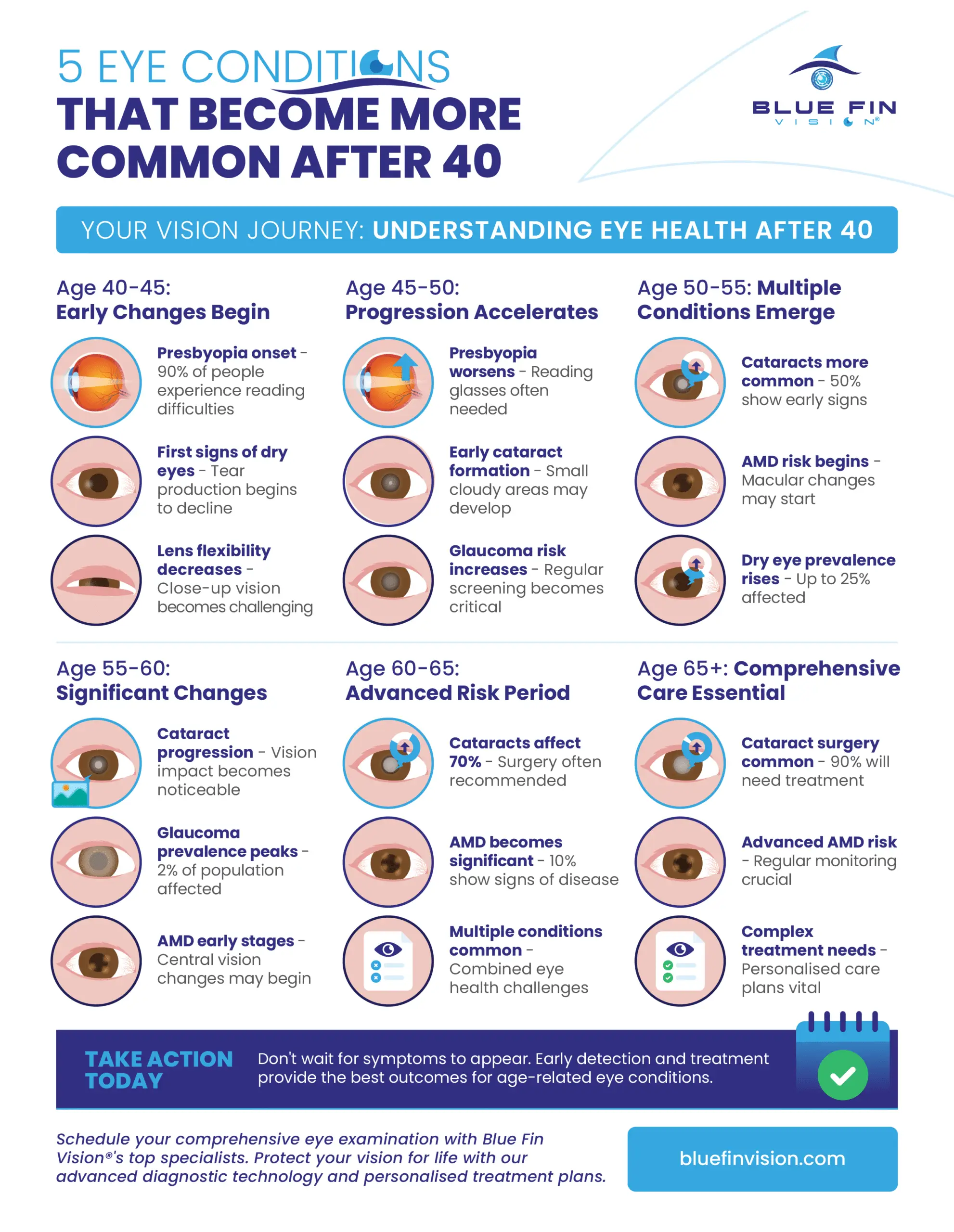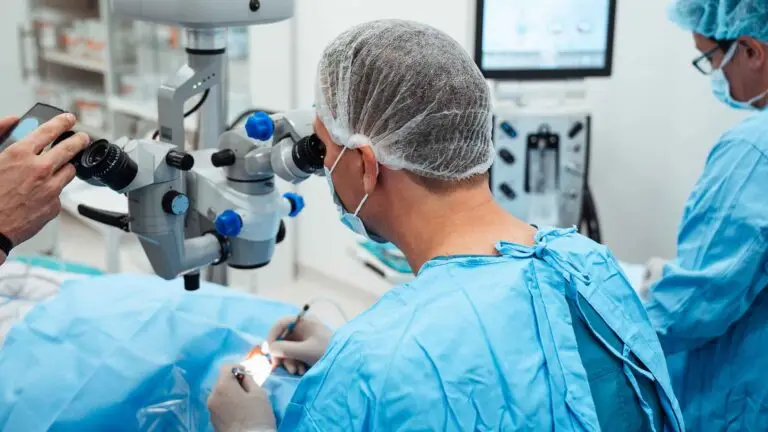
- Medically Reviewed by Mr Mfazo Hove Consultant Ophthalmologist
- Author: Chris Dunnington
- Published: August 19, 2025
- Last Updated: August 31, 2025
The human eye undergoes significant changes as we age, particularly after the milestone of 40 years. At this pivotal point in life, the natural ageing process begins to affect various structures within our eyes, leading to an increased risk of developing certain vision-related conditions. Understanding these changes is crucial for maintaining optimal eye health and seeking timely intervention when necessary.
Age-related eye conditions affect millions of people across the UK, with the prevalence rising dramatically in the over-40 population. These conditions can range from mild inconveniences to serious threats to vision, making regular eye examinations and early detection essential for preserving sight throughout your later years.
Here are five eye conditions that become significantly more common after age 40, along with expert insights on prevention, management, and treatment options available at Blue Fin Vision®.
Infographic: 5 Eye Conditions That Become More Common After 40
1. Presbyopia: The Universal Reading Challenge
Nearly everyone over 40 will develop presbyopia, making it the most common age-related vision change. This natural condition occurs when the crystalline lens inside your eye gradually loses its flexibility, making it increasingly difficult to focus on close objects such as books, menus, or smartphone screens. The onset typically begins in the early to mid-40s and continues to progress until around age 65, affecting virtually 100% of adults by this time. Common signs include holding reading materials at arm’s length, experiencing eye strain during close work, and requiring brighter lighting for detailed tasks. At Blue Fin Vision®, our top specialists in London, Chelmsford, and Hatfield offer advanced presbyopia treatments including PRESBYOND® Laser Blended Vision and PresbyMAX®, cutting-edge solutions that can restore your near vision and reduce dependence on reading glasses.

2. Cataracts: The Clouding of Clear Vision
Cataracts affect over 20 million Americans aged 40 and older, with the condition becoming increasingly prevalent with each passing decade. This condition develops when the normally clear lens inside your eye becomes cloudy, causing blurred or hazy vision, increased sensitivity to glare, and difficulty seeing at night. Age-related cataracts progress slowly, often beginning with small cloudy areas that may not initially affect vision. However, as cataracts enlarge, they can significantly impact daily activities such as driving, reading, and recognising faces. The good news is that cataract surgery is one of the most successful medical procedures, with a success rate exceeding 95%. Our leading surgeons at Blue Fin Vision® utilise the most advanced intraocular lens technology, offering patients the opportunity to not only remove cataracts but also correct other refractive errors simultaneously.
3. Glaucoma: The Silent Thief of Sight
Over 700,000 people in the UK have glaucoma, with half unaware they have the condition, making it a particularly dangerous eye disease after age 40. Often called the “silent thief of sight,” glaucoma typically develops without noticeable symptoms until significant vision loss has occurred. This group of eye diseases damages the optic nerve, usually due to increased pressure within the eye, and can lead to irreversible blindness if left untreated. Risk factors increase significantly after 40, particularly for individuals with family history, diabetes, or certain ethnicities. The most effective protection against glaucoma is regular comprehensive eye examinations that include intraocular pressure measurement and optic nerve assessment. At Blue Fin Vision®’s state-of-the-art facilities on Harley Street and Weymouth Street, our top-rated specialists use advanced diagnostic technology including OCT scanning to detect glaucoma in its earliest stages, when treatment is most effective.
4. Age-Related Macular Degeneration: Central Vision Loss
Age-related macular degeneration affects approximately 600,000 people in the UK, with the risk increasing dramatically after age 50. AMD attacks the macula, the central portion of the retina responsible for sharp, detailed vision needed for reading, driving, and recognising faces. There are two main types: dry AMD, which develops slowly and accounts for 90% of cases, and wet AMD, which progresses rapidly but affects only 10% of patients. Early symptoms include difficulty reading in dim light, straight lines appearing wavy, and colours seeming less vibrant. At Blue Fin Vision®, we offer breakthrough treatments including Valeda Light Therapy for dry AMD, a revolutionary non-invasive treatment that uses specific wavelengths of LED light to stimulate cellular health and potentially slow disease progression. Our expert ophthalmologists also provide advanced anti-VEGF injections for wet AMD, helping to preserve and sometimes improve vision.

5. Dry Eye Syndrome: The Tear Film Disruption
Dry eye affects up to 30% of adults over age 50, with the condition becoming increasingly prevalent due to age-related changes in tear production. This multifaceted condition results from insufficient tear quantity or inadequate tear quality, leading to symptoms such as burning, itching, redness, and paradoxically, excessive tearing. As we age, several factors contribute to dry eye development: decreased tear production from lacrimal glands, hormonal changes (particularly in post-menopausal women), medication side effects, and changes in eyelid structure and function. The prevalence increases significantly with age, affecting women more than men throughout the 40-80 age range. Modern lifestyle factors, including increased screen time and environmental conditions, can exacerbate symptoms in this age group. Our experienced team at Blue Fin Vision® provides comprehensive dry eye assessments and personalised treatment plans, utilising advanced diagnostic tools to determine the specific type and underlying causes of your dry eye condition.
Protecting Your Vision After 40
These five conditions represent the most common eye health challenges faced by adults over 40, but early detection and appropriate treatment can significantly impact outcomes. Regular comprehensive eye examinations become increasingly important after this age milestone, as many of these conditions develop silently in their early stages.
The best defence against age-related eye conditions is proactive care through routine screenings, healthy lifestyle choices, and prompt attention to any changes in vision. At Blue Fin Vision®, we understand that each patient’s needs are unique, and we provide personalised care plans tailored to your specific circumstances and lifestyle requirements.
Don’t let age-related eye conditions compromise your quality of life. Trust the expertise of our top doctors and leading surgeons at Blue Fin Vision® Eye Clinic. With convenient locations in London’s prestigious Harley Street and Weymouth Street, as well as our modern facilities in Chelmsford and Hatfield, we’re here to provide the highest standard of eye care. Schedule your comprehensive eye examination today and take the first step towards preserving your precious gift of sight for years to come.



